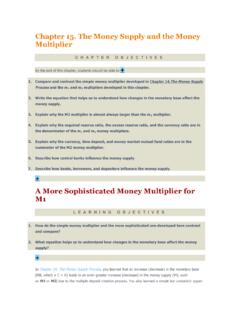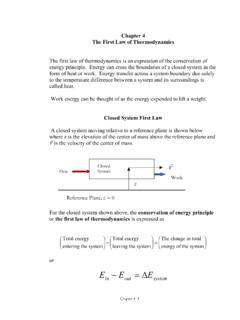Transcription of Chapter 6. Goals and Objectives - Saylor Academy
1 Chapter 6. Goals and Objectives Figure Progress on Goals and Objectives should tell you if you and the organization are on the right track. WHAT S IN IT FOR ME? Reading this Chapter will help you do the following: 1. Understand the nature of Goals and Objectives and why they are important. 2. See how our thinking about Goals and Objectives has evolved. 3. Know what characterizes good Goals and Objectives . 4. Understand the roles of Goals and Objectives in employee performance reviews. 5. Map out relationships among economic, social, and environmental Goals and Objectives . 6. Set and manage your own Goals and Objectives . Goals and Objectives are a critical component of management, both in terms of planning and in terms of the larger planning-organizing-leading-controlling (P-O-L-C) framework.
2 You can see their role summarized in the P-O-L-C figure. Unfortunately, because their role and importance seem obvious, they also tend to be neglected in managerial practice or poorly aligned with the organization s strategy. You can imagine why this might be problematic, particularly since one of a manager s functions is to evaluate employee performance it would be nice if employees could be evaluated based on how their achievement of individual Goals and Objectives contributes to those critical to the organization s survival and success. In this Chapter , we introduce you to the basics on Goals and Objectives and provide you with an understanding of how their usage has evolved.
3 We also show you how to develop a personalized set of Goals and Objectives to help you achieve your personal and professional aspirations. Figure Goals and Objectives in the P-O-L-C Framework Section 1: The Nature of Goals and Objectives LEARNING Objectives 1. Know the difference between Goals and Objectives . 2. Know the relationship between Goals and Objectives . 3. See how Goals and Objectives fit in the P-O-L-C framework. What Are Goals and Objectives ? Goals and Objectives provide the foundation for measurement . Goals are outcome statements that define what an organization is trying to accomplish, both programmatically and organizationally.
4 Goals are usually a collection of related programs, a reflection of major actions of the organization, and provide rallying points for managers. For example, Wal-Mart might state a financial goal of growing its revenues 20% per year or have a goal of growing the international parts of its empire. Try to think of each goal as a large umbrella with several spokes coming out from the center. The umbrella itself is a goal. In contrast to Goals , Objectives are very precise, time-based, measurable actions that support the completion of a goal. Objectives typically must (1) be related directly to the goal; (2) be clear, concise, and understandable; (3) be stated in terms of results; (4) begin with an action verb; (5) specify a date for accomplishment; and (6) be measurable.
5 Apply our umbrella analogy and think of each spoke as an objective. Going back to the Wal-Mart example, and in support of the company s 20% revenue growth goal, one objective might be to open 20 new stores in the next six months. Without specific Objectives , the general goal could not be accomplished just as an umbrella cannot be put up or down without the spokes. Importantly, Goals and Objectives become less useful when they are unrealistic or ignored. For instance, if your university has set Goals and Objectives related to class sizes but is unable to ever achieve them, then their effectiveness as a management tool is significantly decreased.
6 Measures are the actual metrics used to gauge performance on Objectives . For instance, theobjective of improved financial performance can be measured using a number metrics, ranging from improvement in total sales, profitability, efficiencies, or stock price. You have probably heard the saying, what gets measured, gets done. measurement is critical to today s organizations. It is a fundamental requirement and an integral part of strategic planning and of principles of management more generally. Without measurement , you cannot tell where you have been, where you are now, or if you are heading in the direction you are intending to go. While such statements may sound obvious, the way that most organizations have set and managed Goals and Objectives has generally not kept up with this commonsense view.
7 measurement Challenges There are three general failings that we can see across organizations related to measurement . First, many organizations still emphasize historic financial Goals and Objectives , even though financial outcomes are pretty narrow in scope and are purely historic; by analogy, financial measures let you know where you ve been, but may not be a good predictor of where you are going.[261] Second, financial outcomes are often short term in nature, so they omit other key factors that might be important to the longer-term viability of the organization. For instance, return on sales(ROS, or net profit divided by total sales) is a commonly used measure of financial performance, and firms set Goals and Objectives related to return on sales.
8 However, an organization can increase return on sales by cutting investments in marketing and research and development (since they are costs that lessen the return dimension of ROS). It may be a good thing to cut such costs, but that type of cost-cutting typically hurts the organization s longer-term prospects. Decreases in marketing may reduce brand awareness, and decreases in research and development (R&D) will likely stifle new product or service development. Finally, Goals and Objectives , even when they cover more than short-term financial metrics, are often not tied to strategy and ultimately to vision and mission. Instead, you may often see a laundry list of Goals and Objectives that lack any larger organizing logic.
9 Or the organization may have adopted boilerplate versions of nonfinancial measurement frameworks such as Kaplan and Norton s Balanced Scorecard, Accenture s Performance Prism, or Skandia s Intellectual Capital Navigator.[262] Goals and Objectives in P-O-L-C Goals and Objectives are an essential part of planning. They also have cascading implications for all the aspects of organizing, leading, and controlling. Broadly speaking, Goals and Objectives serve to: Gauge and report performance Improve performance Align effort Manage accountabilities Goals , Objectives , and Planning Planning typically starts with a vision and a mission. Then managers develop a strategy for realizing the vision and mission; their success and progress in achieving vision and mission will be indicated by how well the underlying Goals and Objectives are achieved.
10 A vision statement usually describes some broad set of Goals what the organization aspires to look like in the future . Mission statements too have stated Goals what the organization aspires to be for its stakeholders. For instance, Mars, Inc., the global food giant, sets out five mission statement Goals in the areas of quality, responsibility, mutuality, efficiency, and freedom. Thus, Goals are typically set for the organization as a whole and set the stage for a hierarchy of increasingly specific and narrowly set Goals and Objectives . However, unless the organization consists of only a single person, there are typically many working parts in terms of functional areas and product or service areas.









